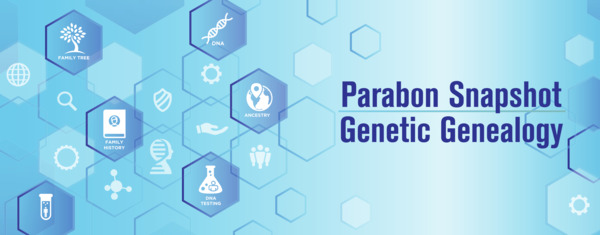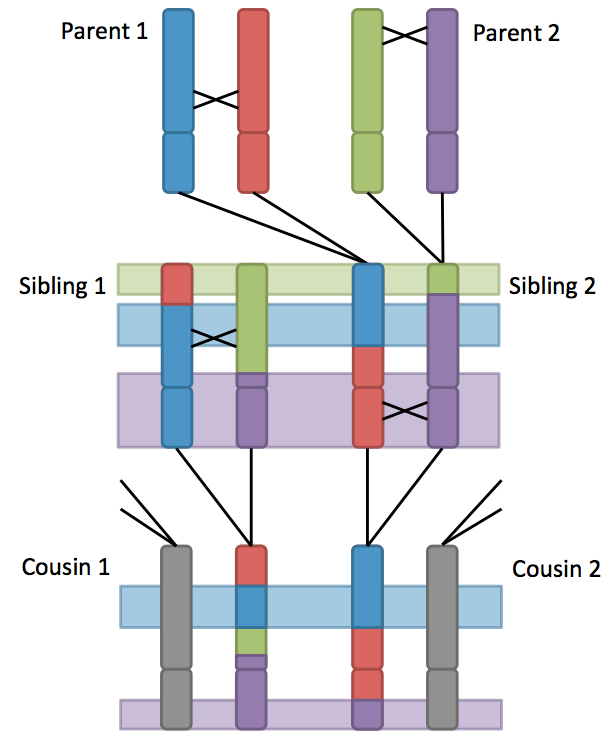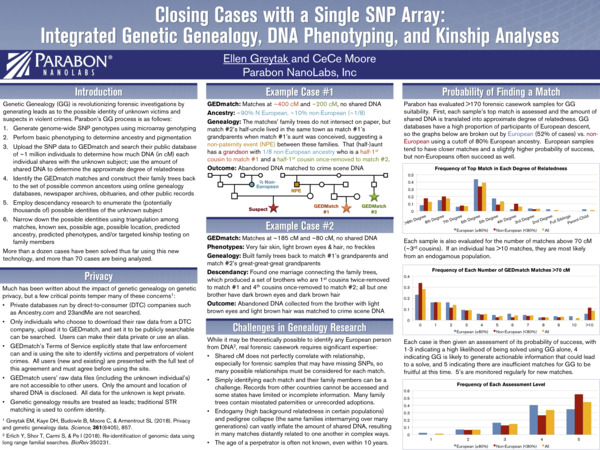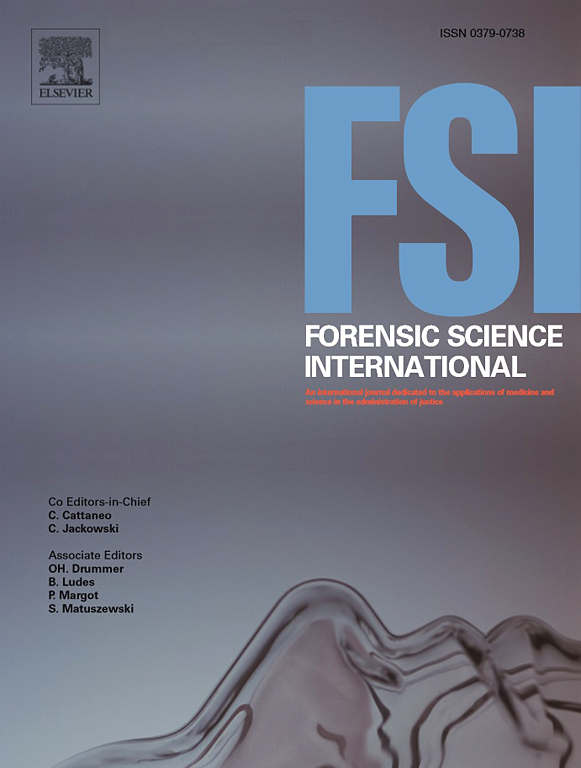Snapshot Genetic Genealogy
Genetic Genealogy (GG) is the combination of genetic analysis with traditional historical and genealogical research to study family history. For forensic investigations, it can be used to identify remains by tying the DNA to a family with a missing person or to point to the likely identity of a perpetrator.

By comparing a DNA sample to a database of DNA from volunteer participants, it is possible to determine whether there are any relatives of the DNA sample in the database and how closely related they are (see Snapshot Kinship Inference for more details). This information can then be cross-referenced with other data sources used in traditional genealogical research, such as census records, vital records, obituaries and newspaper archives.
Why Use Genetic Genealogy?
Genetic genealogy gives you a powerful new tool to generate leads on unknown subjects. When a genetic genealogy search yields useful related matches to an unknown DNA sample, it can narrow down a suspect list to a region, a family, or even an individual. Paired with Snapshot DNA Phenotyping to further reduce the list of possible matches, there is no more powerful identification method besides a direct DNA comparison. Identity can then be confirmed using traditional STR analysis.
How Does This Technique Differ From Familial Searches in the CODIS Database?
Our genetic genealogy service is somewhat like familial search, but it differs in three very important ways: (1) we only search public genetic genealogy databases, not government-owned criminal (STR profile) databases, such as CODIS; (2) because the DNA SNP profiles we generate contain vastly more information than traditional STR profiles, genetic relatedness can be detected at a far greater distance (see Snapshot Kinship Inference); and (3) because genetic genealogy matches can be cross-referenced by name with traditional genealogy sources, such as Ancestry.com, existing family trees can be used to expedite tree-building and case-solving. This technology and our innovative techniques combine to create a groundbreaking system for forensic human identification.
How Genetic Genealogy Works
Genetic genealogy uses autosomal DNA (atDNA) single nucleotide polymorphisms (SNPs) to determine how closely related two individuals are. Unlike other genetic markers, such as mitochondrial DNA or Y chromosome DNA, atDNA is inherited from all ancestral lines and passed on by both males and females and thus can be used to compare any two individuals, regardless of how they are related. However, atDNA SNPs are more difficult to obtain from forensic samples, which is why Parabon has created an optimized laboratory protocol to ensure high-quality results even from small, degraded DNA samples.
The standard atDNA metric used by genetic genealogists is the amount of DNA that two people are likely to have inherited from a recent common ancestor. This can be estimated by looking for long stretches of identical DNA. While alleles can easily be shared by chance at one or a few SNPs, it is highly unlikely for two unrelated people to share a long stretch of DNA. Therefore, only segments above a certain length are counted. The length of these shared segments is measured in centimorgans (cM), a measure of genetic distance, and the total number of cM shared across all chromosomes can be used to determine approximately how closely related two people are. The figure below shows how shared segments of DNA on a single chromosome are broken up with each generation, leading to shorter shared segments for more distant relatives. Using a public genetic genealogy database, DNA from an unknown person can be compared to roughly 1 million other people to see whether any of them are related.

DNA database matches serve as clues on which traditional genealogy methods can build, starting with building the matches' family trees using a wide variety of information sources. During the tree building process, the genetic genealogist searched for common ancestors who appear across multiple family trees of the matches. Ideally, marriages between the descendants of the identified common ancestors are discovered. Then descendancy research is employed to search for descendants at the intersection of these common ancestors who were born at a time that is consistent with the subject's estimated age range. The goal of this search is to narrow down the possible individuals to a set of names, a family, or even an individual.
Depending on the amount of information available from the matches, genetic genealogy can produce a wide range of leads. In all cases that proceed to analysis, genetic genealogy will significantly narrow the scope of possible identities for the person-of-interest. In some cases, the identity will be narrowed to descendants of a particular ancestor or from a particular region. In others, our analysts can produce the name and address of the person-of-interest. In all cases, identity must be confirmed through traditional forensic DNA matching.
Genetic Genealogy Use Cases
Genetic genealogy has traditionally been used to discover new relatives and build a full family tree. However, it can also be used to discover the identity of an unknown individual by using DNA to identify relatives and then using genealogy research to build family trees and deduce who the unknown individual could be. These techniques have primarily been used to discover the family history of adopted individuals, but they apply equally as well to forensic applications. Genetic genealogy has been used to identify victims' remains, as well as suspects, in a number of high-profile cases.
Because genetic genealogy uses the same type of data generated for Snapshot DNA Phenotyping and Snapshot Kinship, the analysis can quickly be performed on existing cases, and new cases have a wide array of options for generating new leads from a single DNA sample.


